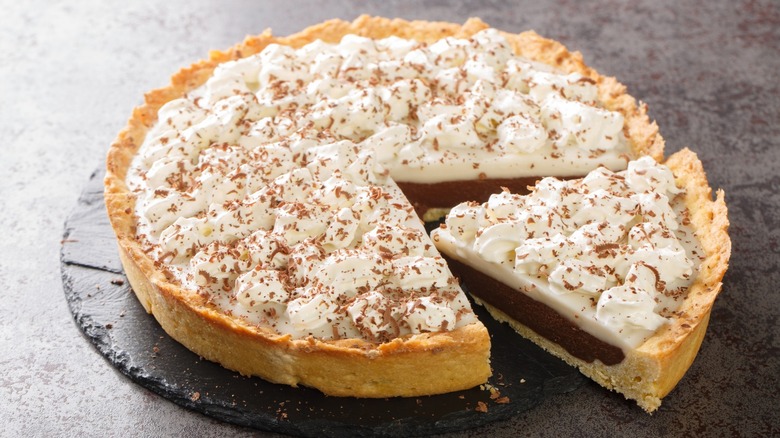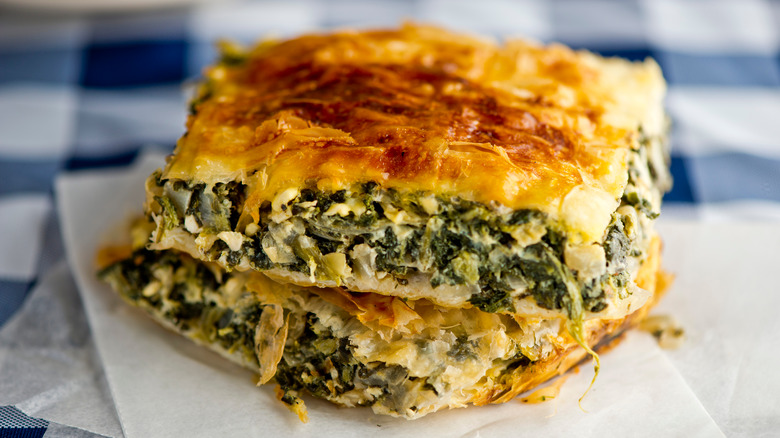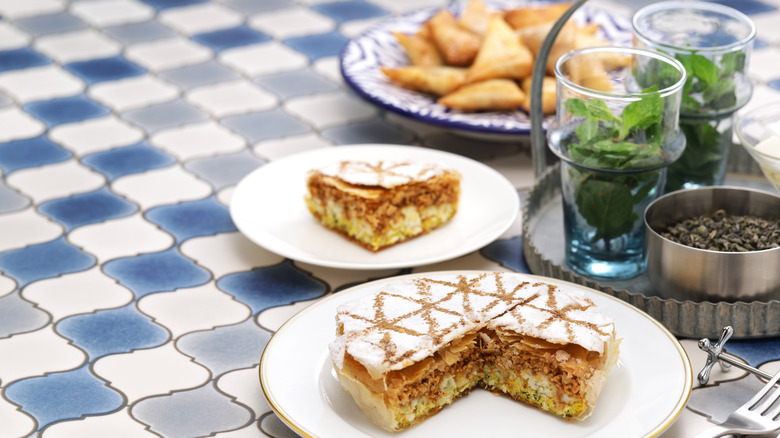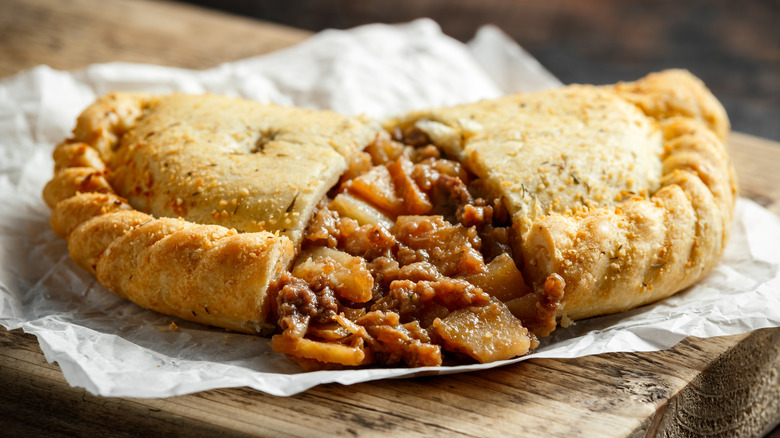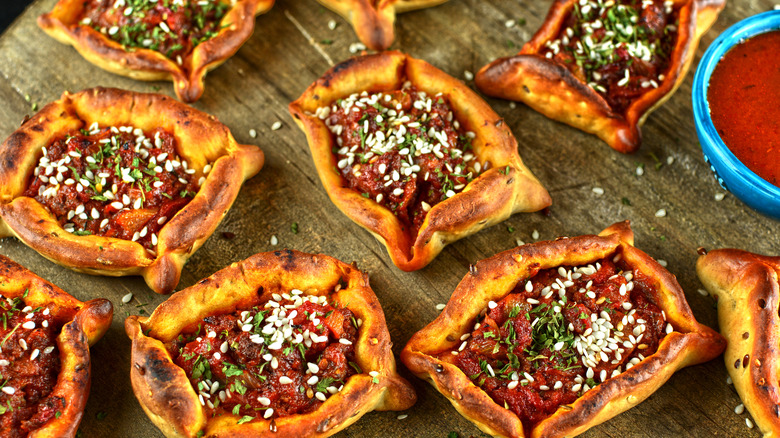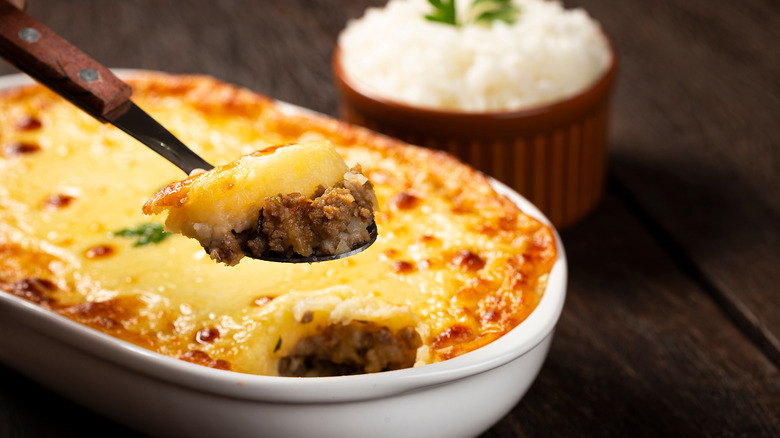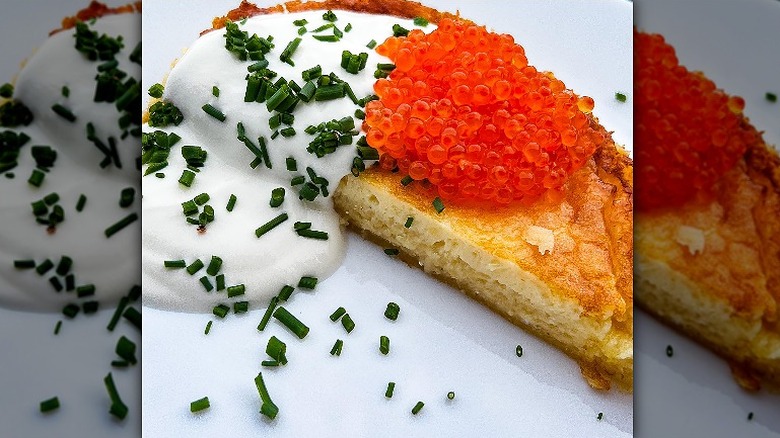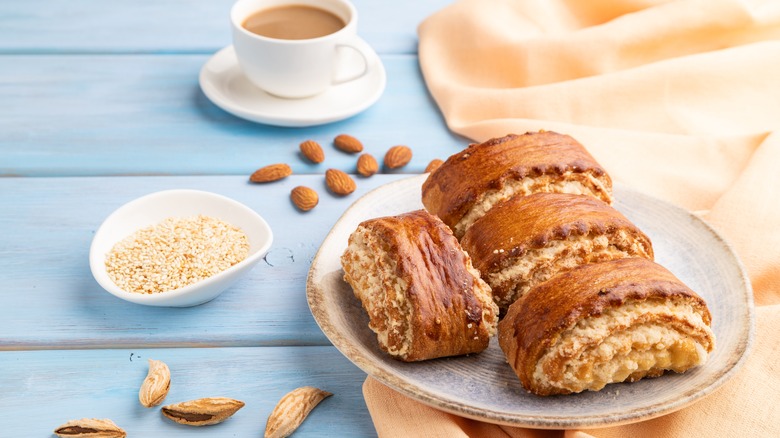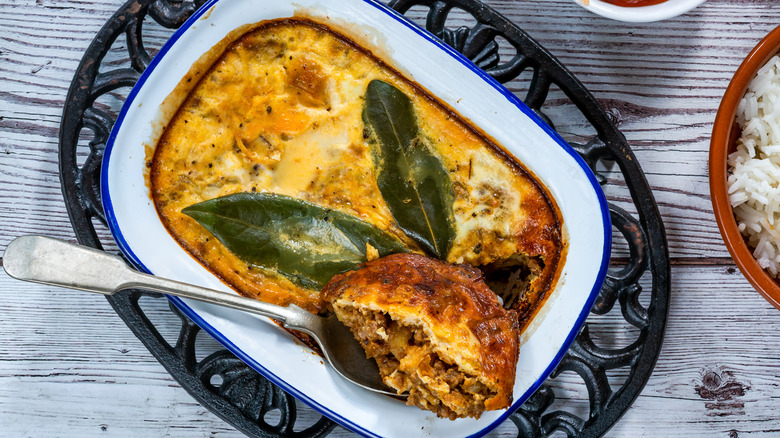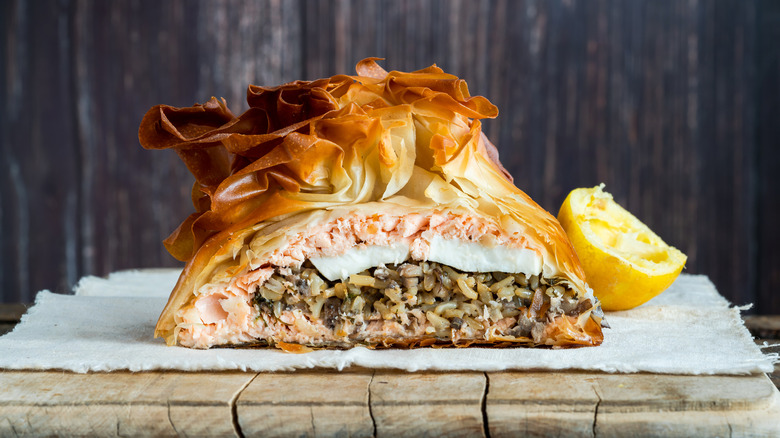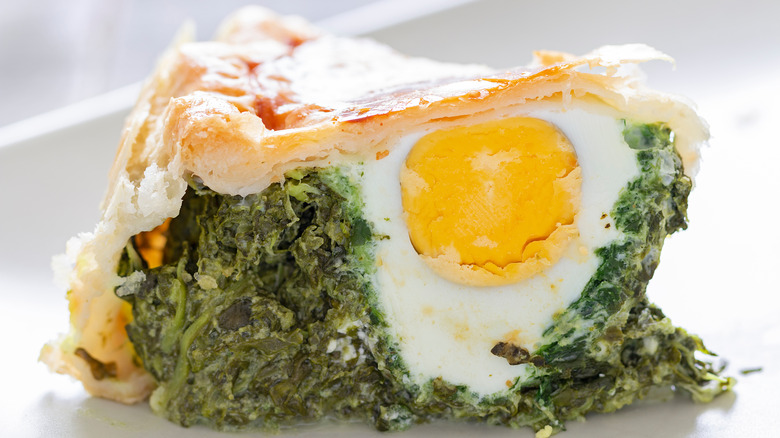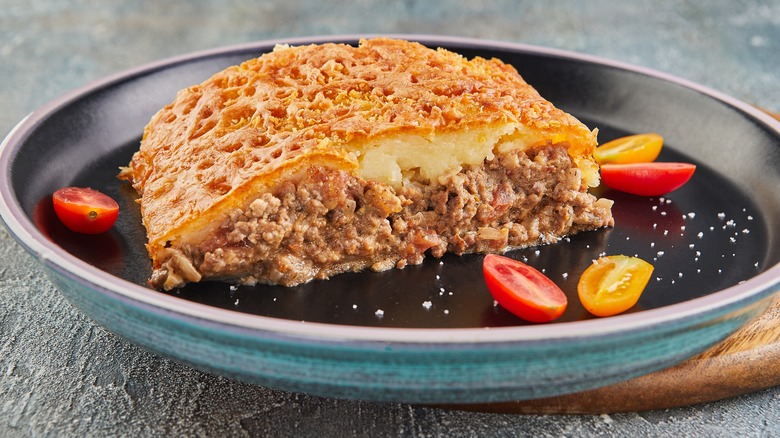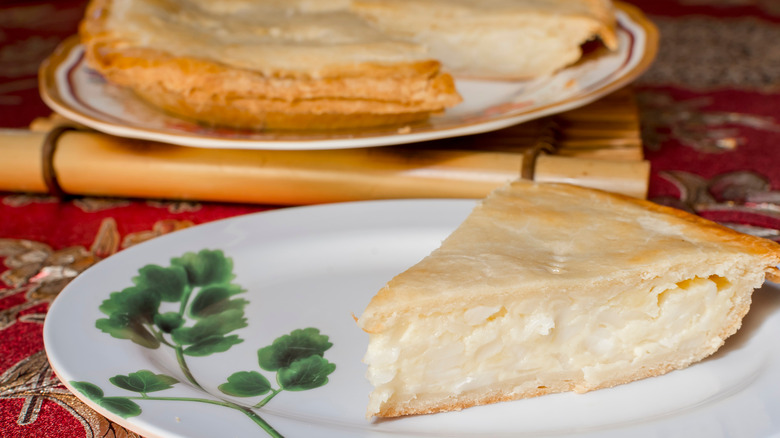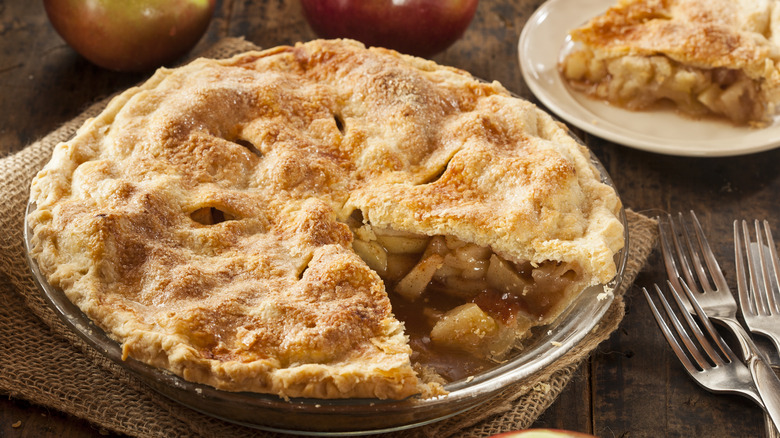13 Pies From Around The Globe That You're Definitely Sleeping On
Whether you call them pie or pita, tart or tarte, placing assorted sweet and savory items into a pastry and baking it is a tale almost as old as time. The earliest evidence of pie can be dated back to 6000 B.C., when ancient Egyptians would create a pie-like facsimile using oat, wheat, barley, and rye filled with honey and baked over an open fire. Subsequent evidence of pie-making can be seen in hieroglyphics in the tomb of King Ramses II, who ruled between 1304-1237 B.C.
The Greeks were responsible for inventing the first variation of what would be considered a modern-day pie crust. This recipe and permutations thereof quickly spread throughout the Roman Empire. By the 16th century, cookbooks of varying European origins included recipes for pies made with pastry doughs. And early settlers of the U.S. brought recipes with them for a collection of sweet and savory pies served at almost every meal throughout the day.
The pie reflects not only the local microclimate and history of a people but every aspect of their culture, including religion, ethnicity, and even political diversity. To experience a pie from a particular country is to peer into the core of who the people of that country are and what their food habits say about them. Let's look at a few of the pies around the globe that you're definitely sleeping on.
1. Spanakopita: Greece
The production of pites, or "pies," in Greece likely emerged hundreds of years ago in modern-day Turkey, a part of the Ottoman Empire. These pites get produced using filo or phyllo dough, a paper-thin dough whose name translates to "leaf." One of the most popular iterations of this type of pie is Spanakopita, or "spinach pie," which features salty feta cheese tucked into layers of filo dough and bathed in heart-stopping quantities of melted butter.
Pites became common as a form of fast food in Greece. Early Greek women would wield their plastis or rolling pins with finesse, churning out delicate filo dough by hand at the speed of lightning. The pita was an easy solution for a one-dish meal. It was portable, did not require utensils, and had a longer shelf-life. It was also a way of repurposing leftovers, which is why so many different iterations of this dish exist.
A more rustic version of Spanakopita gets made with horiatiki, which is a kind of puff pastry. There are also vegetarian permutations made without cheese or butter, consumed by Greeks fasting during Lent.
2. B'stilla: Morocco
Whether you call it B'stilla, Bastilla, Bastila, Bisteeya, or Pastilla, this centuries-old delectable pie hailing from Fez, Morocco, is one of the most distinctly elegant and complex pies you will ever consume. It is quintessentially Moroccan in its flavor profile, juxtaposing the sweetness of almonds, cinnamon, and powdered sugar with the gaminess of pigeon meat stewed with onions and combined with scrambled eggs. All of this gets tucked into layer after layer of a paper-thin pastry indigenous to Morocco, known as warqa. This pastry can be seen being made by dadas – women cooks – throughout the street markets of Morocco. It gets assembled in a custom hand-hammered metal B'stilla pan that is approximately 1" deep.
While this dish historically was served during special occasions due to the complexity of composing it, it has become more common, particularly at restaurants catering to tourists. Variations of this dish can include numerous ingredients ranging from seafood to a dessert custard. However, most households now use chicken, which is often purchased live, brought home, and fed a diet of either fresh herbs included in the dish or almonds to give the meat a distinct aroma and color. The final culinary creation is always garnished with copious quantities of powdered sugar and ground cinnamon, giving it a beautiful tableside presentation.
3. Pasties: England
Variations of the pasty are traceable back to 13th-century Britain. In that era, the pasty was a cherished dish with royalty, a handheld pie often stuffed with seafood, venison, lamb, and fruit. It became popularized in the 17th and 18th centuries in Cornwall, England. Cornish pasties were an efficient meal delivery system for tin miners. Their wives would stuff these pastries with rustic affordable ingredients like potatoes and onions. They would then crimp the pastry shut and imprint their initials into them to ensure the proper pasty made its way down the coal shaft at lunchtime.
Raw pasties were cooked by bal-maidens and then sent down the shaft as miners recanted the rhyme "Oggie, Oggie, Oggie," a pun stemming from the Cornish word for pasty, or "Hoggan." Freshly baked pasties were kept on their person, keeping them warm and providing a hot meal for up to 10 hours. Because the miners would often get dirty hands contaminated with toxic arsenic, the rims of the pasty were used as handles, allowing them to eat the center safely without poisoning themselves. Once the center of the pasty was consumed, the remainder was thrown away. With British colonization, variations on the pasty have become ubiquitous in countries across the globe.
4. Sfeeha: Lebanon
Sfeeha is a pizza-like meat pie common in Lebanese cuisine, with similar dishes throughout the Middle East, like the Turkish Lahmacun. While variations of sfeeha are as diverse as the households, it is not uncommon for this dish to get filled with ground lamb or goat. They are available throughout street markets in bakeries called "foren," the Lebanese term for "oven." Sfeeha gets made open-faced, partly folded, or entirely encased in pastry.
A popular variation of this pie hails from the village of Baalbek in northeastern Lebanon, one of the most popular tourist destinations thanks to the proliferation of Roman temples there. This version has the distinct flavors of pomegranate molasses, Labneh (a type of yogurt), and tahini or sesame paste juxtaposing the rich lamb. Sfeeha can come in entrée portions or bite-sized appetizer pies. While the dough typically used is more like bread dough, store-bought pizza dough can get substituted. Additionally, many modern-day variations substitute ground beef for lamb, which tends to be more widely popular.
5. Shepherd's pie: Ireland
While corned beef and cabbage is the dish most often associated with Ireland, one that is more humble yet equally Irish is shepherd's pie. This dish has a less clear past than you may presume, attributable to the long, fraught history between Ireland and England. After England took control of Ireland in the 15th century, Irish Catholics became relegated to being working-class people living in modest homes called "cottages." In 1589, Sir Walter Raleigh brought the potato to Ireland, where it quickly became adopted as a staple food item. Around this time, beef production boomed in Ireland due to the English affinity for beef. These factors together led to what became known in the 19th century as cottage pie but is now called shepherd's pie.
This dish, made with ground meat, gravy, onions, carrots, celery, and a mashed potato crust, is less a pie in the traditional pastry-filled sense, and yet every bit a product of the same mentality. It's a one-dish wonder that can serve a big family while using up leftovers.
Since the Irish were more of a sheepherding country, they likely made their pie with mutton, hence the name shepherd's pie. The English opted to make their variation with beef, thus maintaining an affinity to the term cottage pie. Whichever name you go by, it is a hearty meal perfect for a cold, dreary day.
6. Västerbottenpaj: Sweden
This pie, or "paj" as pie is known in Sweden, is more like a cheese tart made with a distinctly Swedish cheese called Västerbotten. This cheese was invented in 1872 by a young woman named Ulrika Eleonora Lindström in Burträsk, a village in northern Sweden. Its distinct flavor is a product of the milk derived from the cows in the region and the unusual cheese-making process used to make this cheese. Västerbotten is illegal in many countries because of the addition of sodium nitrate. However, other cheeses can get substituted in making this pie, like an aged cheddar or other semi-hard Swedish cheese.
While the basic recipe is similar across the country, ranging from more to less cheesy, there are four basic variations. One is a variation using a pastry crust made with rye flour. The second uses milk instead of cream for a less dense filling. The third takes advantage of the wild mushroom foraging fanaticism among the Swedes by incorporating them into the filling. And finally, a version can get garnished with a Swedish sour cream called Gräddfil and Kalix löjrom (vendace roe). This dish is common during Kräftskivor, or crayfish parties, during August.
7. Gata: Armenia
Gata is a sweet, bread-like pie typically filled with a custard made from ghee, sugar, vanilla, and Armenian cognac. It is most commonly associated with the monastery in Gerhard in Armenia's Upper Azat Valley. This monastery is a UNESCO world heritage site that began construction around 1250, right after Christianity became the official state religion of Armenia. The monastery carved out of the rocks continues to be a popular tourist attraction, where older women line the streets selling distinctly decorated Gata to visitors. These special gata are gilded with decorative symbols heralding their origins as part of the legacy of the historic monastery.
The gata symbolizes the sweetness of freedom and liberty associated with the ability to observe the Christian faith free of persecution. It often finds its way into wedding celebrations where the pie gets broken over the heads of the newlyweds for good luck. Additionally, it is served to travelers to wish them safe journeys. Though eaten year-round, the most traditional time to consume gata is during the Christian holiday known as Candlemas, which is observed 40 days after Christmas according to the Armenian calendar.
8. Bobotie: South Africa
Bobotie, considered the National Dish of South Africa, is one that characterizes the deeply complex legacy of colonization, slavery, and ongoing strife epitomizing the diverse country. The recipe is akin to a casserole making its reference to a pie natural. It is made by layering soaked bread with a rich mixture of ground beef or lamb, curry, ginger, lemon, dried apricots, raisins, and almonds or walnuts. Its name either refers to the Indonesian bobotok, a dish made with coconut, or the Malaysian boemboe, which refers to any dish with curry spices.
Its origin dates back to the mid-17th century when The Dutch East India Company developed a slave colony of predominantly Indonesian and Malaysian Muslims in Cape Malay. These enslaved people took advantage of locally available ingredients creating their variations of classic fare, and bobotie was born. It became hugely popular, even among those outside the Cape Colony. Once the enslaved people were released and made their way into other communities, they took this dish with them, slowly introducing it to South Africans from all walks of life. Today, the majority of their descendants reside in the Bo Kaap community of Cape Town, where the finest examples of bobotie are available for sampling.
9. Coulibiac: Russia
Coulibiac is a Russian pirog, or pie, originating in the legendary kulebyaka, a type of layered tower of ingredients often featuring Vyaziga (the dried spinal cord of sturgeon) in variations made for nobility. The modern iteration of coulibiac is a meal in a pie, layering salmon with rice, hard-boiled eggs, mushrooms, dill, shallots, and the sour cream-like Smetana. While the exact ingredients may vary by household and available fish, the basics are the same. Each component is carefully layered and encased in a pastry resembling a puff pastry or a brioche.
This dish became popularized by the legendary French chef Auguste Escoffier in the 19th century. Escoffier learned to make a variation of coulibiac to honor officers of the Russian navy who were guests at his uncle's restaurant in Nice, France, the Restaurant Français. The dish became even more of a household name thanks to a not-so-small personality in stature or reputation — Julia Child. Her adaptation lightened and simplified the recipe, making it far more accessible for average home cooks to replicate. Some modern versions substitute smoked or cured salmon for poached salmon and flavored rice rather than plain rice to impart a more robust flavor.
10. Torta Pasqualina: Italy
Torta Pasqualina, or Easter Pie, is a traditional dish that originated in the 16th century in the Ligurian capital of Genoa. This region of Northern Italy along the Mediterranean Sea is known for fresh produce, like dandelion, chard, spinach, marjoram, leeks, artichokes, and mushrooms, that often make their way into this Spring dish. Historically, wheat was considered a commodity in this area of northern Italy. As a result, each torta was made out of pastry produced with just a single pound of flour. This process yielded a thin dough that was layered throughout the dish with hard-boiled eggs and a ricotta-like cheese indigenous to the region called prescinsêua.
The symbolism of the ingredients in the pie speaks to its historical origins. Since Torta Pasqualina is served on Easter Monday, 13 eggs aret included in the recipe, one for Christ and one for each of his apostles. Additionally, 33 layers of pastry get implemented, one for each year Christ was alive. Modern variations of this dish often substitute phyllo dough for the classic torta dough, and the prenscinsêua cheese gets substituted with ricotta mixed with Greek yogurt.
11. Tourtière: Canada
While tourtière is now a classic symbol of French-Canadian cuisine, its origins pre-date the existence of Canada as a country. In the 1600s, Quebec was a French settlement, and this rich meat pie was a staple of every Christmas Eve post-Mass celebration. Its most well-known iteration derives from the Saguenay Lac-St-Jean region of Quebec, but different permutations exist from one household to the next.
A classic tourtière was made with a combination of finely-chopped pheasant, rabbit, moose, and pigeon seasoned with festive holiday spices, including cinnamon, clove, allspice, and nutmeg. The crust is a typical flaky double pie crust, completely encasing the savory ingredients while the dish bakes in the oven. Modern variations tend toward more mainstream meats, like ground beef, veal, or pork.
While it is still considered a holiday specialty, this pie is consumed year-round, especially when families gather for a meal. It often gets served with a condiment reminiscent of homemade green ketchup or plain Heinz ketchup as a garnish. Whichever recipe you try, we guarantee this dish will make your hearts go on and on.
12. Buko: Philippines
Although buko pie is as synonymous with the Philippines as apple pie is with the U.S., it is a relatively recent addition to the culinary lexicon of the island nation. Originating in the Laguna province of the largest island in the Philippines, namely Luzon, buko pie was invented in 1965 by a woman named Nanette Pahud. Pahud, a native Filipino, spent the 1950s working alongside an American professor stationed at the University of the Philippines in Los Banos, Laguna. While there, she perfected her baking abilities, becoming quite adept at making apple pie. Yearning to recreate something similar, she sought to adapt her recipe to ingredients that were indigenous to the Philippines. Enter buko or young coconut.
Buko, or young coconut, has a green exterior and a tender custardy interior. The young coconut combined with sweetened condensed milk poured into a pie crust is revolutionary. The dish is now a popular pasalubong or souvenir. This phrase in Tagalog translates to "bring home something for me," and a common thing to bring home involves a food item. Buko pies are now found throughout the Philippines, although the original recipe can still get sampled at Pahud's original bakery — Orient Bakery.
13. Apple pie: United States
What could be more American than apple pie? It turns out that it isn't actually American, but we love it and have adopted it as our own. When the pilgrims came to America, they brought European apple tree cuttings and seeds as part of their supplies. They expeditiously spread these throughout the colonies. By 1800 there were 14,000 varieties of apples being grown in the U.S.
The pie as we know it was introduced by Dutch immigrants in the 1700s. They were well-versed in the type of flaky pie crust traditionally associated with a good apple pie. The clever colonists took advantage of the prolific apple varieties growing to create one of the first original American-born apple pies. A variation of a recipe for the pie was included in the first cookbook published in the U.S. in 1796, just a few years after Independence, titled "American Cookery."
While the phrase "American as apple pie" may have originated with the legend of Johnny Appleseed, its use became popularized during World War II. Soldiers were fond of saying they enlisted in the army "for mom and apple pie." The love affair between Americans and apple pie has remained strong ever since then.
